
TREND 1: Misuse of analgesics. In recent years, high school football players seeking an edge have swigged Red Bull and similar energy drinks, taken too many vitamins and supplements, and made the bad, bad mistake of injecting steroids. Steroid use is rare in the NFL and NCAA Division I, owing to random drug testing. Thankfully, Florida and New Jersey already test high school football players for steroid use, and Texas is about to announce a major testing program -- making it likely that steroid testing for high school players will become common, and thus that the steroid bane will be eliminated. Meanwhile, creatine -- used by many high school athletes in lieu of steroids because it's legal, although it's feared to be steroidlike -- turns out to be reasonably safe. (See below.) That leaves my big worry: the abuse of naproxen.
For a long time, high school football players have gulped aspirin before games as a prophylactic against minor pain from being slammed into. Today, stronger analgesics are available over the counter -- the "nonsteroidal anti-inflammatories," especially ibuprofen (commonly sold as Motrin or Advil) and naproxen (commonly sold as Aleve). Ibuprofen and naproxen are safe when taken as directed. The worry is that high school boys are ingesting several times the recommended dose before scrimmages or games, thinking this will protect them against pain. Naproxen, especially, is a strong drug that interferes with the body's production of prostaglandins, hormonelike compounds that play a role in pain and inflammation. Until 1991, naproxen was available only by prescription in the United States, and it is still prescription-only in many European nations.
An Aleve capsule contains 220 milligrams, and the recommended dosage is one capsule every eight to 12 hours. That's safe. But TMQ has heard that high school boys are popping as many as half a dozen Aleves (or other brands of naproxen) before games, thinking this will make them immune to pain and swollen ankles. It won't -- "If one is good, six is six times better" is not medical thinking -- but such amounts can be very dangerous. Prostaglandins serve a biological role in regulating the body's protection against injury. Block them with excessive dosages of naproxen or another drug, and you risk making injuries worse, rather than preventing them. Prostaglandins function like hormones, and you don't want to be conducting unauthorized experiments with your hormones -- especially because prostaglandins play a role in your blood pressure, which needs to be regulated during intense athletics. High doses of ibuprofen or naproxen can also inhibit blood clotting. A football player who sustains a concussion with high doses of blood-thinning compounds in his body is at risk for cerebral bleeding. Hey, high school boys, do not pop Aleve! And high school coaches and doctors, be on the lookout for misuse of nonsteroidal anti-inflammatories. Just because a pill is available over the counter doesn't mean you should swallow as many as you like.TREND 2: High school recruiting and district-hopping. Friendly High, The Washington Post's No. 1-ranked team in the Washington-Baltimore region, just forfeited six games (and its playoff hopes) because the school was using a player who only claimed to live within its boundaries. (Check out Friendly's logo -- Bill Belichick must have been behind the attempted cheating somehow.) Josh Barr, one of the country's top reporters on high school athletics, reports that six Maryland high schools -- all of them football powers -- have forfeited games this season, owing to use of ineligible or out-of-district players. Meanwhile, Washington, D.C., just postponed its playoffs for a week because powerhouse Ballou High forfeited games because it had used of an out-of-district player. The forfeit put a disbanded team into the playoffs.
| TMQ Cheat Sheet |
|---|
|
Gregg Easterbrook on ...
• Stats of the week • Cheerleader of the week • Sweet/sour plays of the week • Biology boosts your ego • Creatine -- safe? • The football gods were torn • Christmas excess goes global • Why certain teams are 0-9 • The football gods were not torn • Train-wreck team |
Though I don't know of any central source of statistics on this -- if you do, use the e-mail address at the end of this column -- but my impression is that the number of games forfeited because of out-of-district or ineligible players has risen in recent years. And I can't prove this, either, but I believe informal recruiting -- families with promising athletes moving into the districts of powerhouse high schools, or arranging for athletes to live with someone within the district -- is also up. Carroll High of Southlake, Texas, has won the Texas state championship in its school-size category four of the past five years, and even though the Dragons play very well, it's hard to believe that, solely by chance, year after year, the most promising football players in Texas are born in that school's district. Nationwide, several dozen powerhouse public high schools dominate year after year, and good luck in terms of births inside their districts cannot really explain that.
What appears to be going on here is an increasing pressure placed on high school football, coupled with an ever-higher awareness of corporate interest and college recruiting. Boys want to play for powerhouse teams because it increases their chances of getting recruiting offers. After observing a certain professional team we'll call "the New England Patriots" running up the score, boys want to play for teams that don't just win but humiliate opponents. After observing pop culture celebrities who are empty-headed but boast and strut, boys want to play for powerhouse schools that win big, so they can boast and strut. The boys end up being empty-headed themselves, with education being lost in the district hopping.

AP Photo/Manuel Balce Ceneta
The First Amendment, privacy rights, high school football recruiting -- all the great issues of the day are heard here.
TREND 3: Now for some good news. There's a high school in Arkansas that has made the most significant football innovation we've seen since the veer option. This high school is tearing up its state and is on the verge of revolutionizing the way football is played. TMQ suspects that within a few years, the phrase "Pulaski theory" will be as widely known as the phrase "shotgun spread." In a copycat sport, Pulaski Academy of Little Rock has devised an offensive philosophy that is genuinely new, and it's winning games left and right.
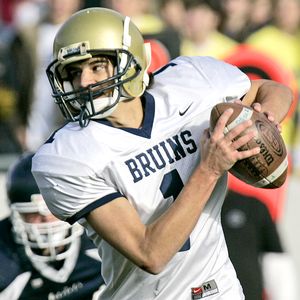
AP Photo/Danny Johnston
Pulaski football -- at the cutting edge of sports innovation.
I first heard about Pulaski from Peter Giovannini of Morrilton, Ark., a high school football official who wrote me to report in astonishment that he had just worked a conference championship game in which the winning team never punted, even going for a first down on fourth-and-6 from its own 5-yard line early in the game. "As a devotee of TMQ, I thought you might like to know at least one coach in the vast football universe has experienced the epiphany and refuses to punt the ball away," Giovannini wrote.
That team was Pulaski -- 9-1-1 after having just won its opening-round game in the Arkansas 5A playoffs. Coach Kevin Kelley reports that he stopped punting in 2005 -- after reading an academic study on the statistical consequences of going for the first down versus handing possession to the other team, plus reading Tuesday Morning Quarterback's relentless examples of when punting backfires but going for the first down works. In 2005, Pulaski reached the state quarterfinals by rarely punting. In 2006, Pulaski reached the state championship game, losing by one point -- and in the state championship game, Pulaski never punted, converting nine of 10 fourth-down attempts. Since the start of the 2006 season, Pulaski has had no punting unit and never practices punts. This year, Pulaski has punted just twice, both times when leading by a large margin and trying to hold down the final score. In its playoff victory Friday night, Pulaski did not punt, converting three of four fourth-down tries.
"They give you four downs, not three," Kelley told TMQ. "You should take advantage. Suppose we had punted from our own 5. The odds are the opposition will take over at about the 35, and from there the stats say they have an 80 percent chance of scoring. So even if you only have a 50 percent chance of converting the first down, isn't that better than giving the other side an 80 percent chance of scoring?" For fourth-and-short attempts, the odds of converting are a lot better than 50 percent.
 As TMQ endlessly notes, NFL teams convert about 75 percent of fourth-and-1 tries. Yet highly paid professional coaches endlessly send in the punt unit on fourth-and-1, handing a scoring opportunity to the opposition. In the 2006 edition of my annual don't-punt column, I summarized the odds this way: "Nearly three-quarters of fourth-and-1 attempts succeed, while around one-third of possessions result in scores. Think about those fractions. Go for it four times on fourth-and-1: Odds are you will keep the ball three times, and three kept possessions each with a one-third chance of a score results in your team scoring once more than it otherwise would have. Punt the ball on all four fourth-and-1s, and you've given the opponents three additional possessions. (It would have gotten one possession anyway when you missed one of your fourth-and-1s.) Those three extra possessions, divided by the one-third chance to score, give the opponent an extra score."
As TMQ endlessly notes, NFL teams convert about 75 percent of fourth-and-1 tries. Yet highly paid professional coaches endlessly send in the punt unit on fourth-and-1, handing a scoring opportunity to the opposition. In the 2006 edition of my annual don't-punt column, I summarized the odds this way: "Nearly three-quarters of fourth-and-1 attempts succeed, while around one-third of possessions result in scores. Think about those fractions. Go for it four times on fourth-and-1: Odds are you will keep the ball three times, and three kept possessions each with a one-third chance of a score results in your team scoring once more than it otherwise would have. Punt the ball on all four fourth-and-1s, and you've given the opponents three additional possessions. (It would have gotten one possession anyway when you missed one of your fourth-and-1s.) Those three extra possessions, divided by the one-third chance to score, give the opponent an extra score."
Kelley says that when he began to shun the punt, people thought he was crazy: "It's like brainwashing, people believe you are required to punt." Players and the home crowd needed to get acclimated to it. "When we first started going on every fourth down," he says, "our home crowd would boo and the players would be distressed. You need to become accustomed to the philosophy and buy into the idea. Now our crowd and our players expect us to go for it, and get excited when no punting team comes onto the field. When my 10-year-old son sees NFL teams punting on short yardage on television, he gets upset because he's grown up with the idea that punting is usually bad."
Preparing the players for the no-punting future of football is a practical concern. If a coach unexpectedly kept his offense in on fourth down in his own territory, and failed to convert, the crowd would boo and the defensive players become demoralized. If the defensive players understood that a no-punting philosophy occasionally would hand great field position to the other side but overall would keep the other side off the field, they would buy into the idea. Imagine, in turn, the demoralizing effect on the opposition if its defense stops its opponent after three downs, only to realize that no punt will follow. For the 2007 edition of my anti-punting column, the stats service AccuScore did thousands of computer simulations based on 2006 NFL games and found that, on average, rarely punting added one point per game to the score of the teams that didn't punt, while not adding any points to their opponents' final scores. Computer simulations showed that rarely punting amounted to roughly one additional victory per season at the NFL level. At the college and high school levels, the bonus might be even higher.
Why do coaches punt on fourth-and-short -- and worse, when trailing or in opposition territory? "Most punting is so the coach can avoid criticism," says Kelley, who has coached Pulaski for five years and got his start in high school coaching in football-crazed Texas. "If you go for it and fail, the first question in the postgame press conference will be, 'Aren't you to blame for losing the game because you didn't punt?' If the coach orders a punt, the media will blame the defense." TMQ has always speculated that the desire to shift blame explains why big-college and NFL coaches send in the punting team. But take note, these days, the media and the postgame news conference are factors even at the high school level.
Pulaski Academy is providing real-world evidence of the future of football. The most important innovation in years is being field-tested by the Pulaski Bruins, and the test is going quite well. But don't just take Kelley's word for it. The decisive snap of Illinois' upset of No. 1 Ohio State on Saturday came when the Illini, leading 28-21 with six minutes remaining, went for it on fourth-and-1 in their own territory. Sports radio generally called this a huge gamble. Actually, it was playing the percentages; Illinois converted and held the ball for the remainder of the game. Had Illinois boomed a punt, the Buckeyes would have been in business. On Sunday, while trailing at Washington, Philadelphia went for it on fourth-and-1 in its own territory in the second half -- Fox television announcer Daryl Johnston called this "a huge gamble!" It was playing the percentages; the Eagles converted, and they scored a touchdown on the possession, igniting a comeback. Trailing 10-2, Buffalo went for it on fourth-and-1 from the Dolphins' 24 in the fourth quarter: a conversion, followed by a touchdown on the possession, keyed the Bills' comeback. Leading defending champion Indianapolis 16-0, San Diego went for it on fourth-and-2 at the Indianapolis 37, converted and scored a touchdown on the possession, going on to win by two points. Three times Jacksonville went for it on fourth-and-short in Tennessee territory, all three times converting and going on to score touchdowns; the Titans went for it on fourth-and-short twice in return, once failing and once scoring a touchdown. As noted by reader Rene Derken of Leuth, the Netherlands, Green Bay went for it twice on fourth-and-short in Minnesota territory, both times scoring on the possession -- but Minnesota punted from the Green Bay 42. Carolina went for it on fourth-and-1 from the Atlanta 20, and the play reached the Falcons' 2 before the Panthers' runner fumbled. Yes, New Orleans failed on a fourth-and-1 attempt in its own territory and went on to lose, and San Francisco failed on a fourth-and-1 on the Seattle 2-yard line when trailing big. But of the high-profile fourth-down tries in the NFL and in the Illinois-Ohio State game this past weekend, 10 were a total success, one a qualified success and three a failure. Not too shabby, compared with passively punting the ball.
And consider the punts that boomed when a play should have been run. Trailing 10-0, San Francisco (2-6) punted on fourth-and-1 from their 48-yard line and several minutes later was trailing 17-0. When the game was still tied, the Giants punted on fourth-and-2 from the Dallas 45. Not coincidentally, by game's end they were desperate for points.
See below for other high school items scattered through this column.
In pro football news, San Diego's victory over Indianapolis reduces the odds of New England having a perfect season. Why? Now the Colts' best possible record is 14-2. And because the Patriots defeated Indianapolis and thus hold the head-to-head tiebreaker, a 14-2 finish by New England now locks up the first seed in the AFC. That means that even if Indianapolis wins every remaining game down the stretch, should New England reach 14-0, it will have secured homefield advantage throughout the playoffs. (The only other AFC team that can finish 14-2 is Pittsburgh; to reach 14-0, New England must defeat Pittsburgh on Dec. 9, leaving the Steelers' best potential finish at 13-3.) History shows that once a team locks up homefield advantage throughout the playoffs, it's very difficult to get motivated to win and coaches grow conservative and rest starters with the slightest injuries. Should New England reach 14-0, even the mad-at-the-world Flying Elvii might have trouble caring about meaningless games, focusing their energies instead on the postseason.
Stat of the Week No. 1: Stretching back to last season, the Packers and Steelers are on a combined 23-4 run.
Stat of the Week No. 2: Aveion Cason was Detroit's leading rusher, with 1 yard gained.Stat of the Week No. 3: At 1:59 p.m. Eastern on Nov. 11, the St. Louis Rams took a lead on the road for the first time in the 2007 season.
Stat of the Week No. 4: After allowing the Titans 282 yards rushing in their first meeting, Jacksonville held Tennessee to 62 yards rushing.
Stat of the Week No. 5: New England, the highest-scoring team in the NFL, has scored 3.4 points for every point by San Francisco, the lowest-scoring team.
Stat of the Week No. 6: In its past three games, Buffalo has outscored opponents 38-0 in the fourth quarter.
Stat of the Week No. 7: One week after outrushing San Diego by 336 yards, Minnesota was outrushed by Green Bay.
Stat of the Week No. 8: Since his return to the NFL, Joe Gibbs is only 17-13 when the Redskins lead at halftime.
Stat of the Week No. 9: (College stat bonus.) North Texas gained 635 yards, scored 62 points -- and lost. In the Navy-North Texas game, there were 19 touchdowns versus three punts.
Stat of the Week No. 10: Miami is 6-20 since the moment Sports Illustrated predicted the Dolphins would win the Super Bowl.
Cheerleader of the Week: Reader Hayden Maxwell of Jacksonville nominates Liana Rothstein of the Jaguars' Roar. According to her team bio, Liana is an attorney: "Your Honor, my attorney will be present as soon as she finishes posing for the swimsuit calendar." Having a cheer-babe represent you in court might be a canny strategy, especially if the judge allowed her to wear a two-piece. Here is an attorney cheer:Collateral, collateral
Estoppel!
When we testify,
We give 'em [heck]!
Sweet Play of the Week: With Green Bay leading Minnesota 13-0, the Packers faced second-and-goal on the Hyperboreans' 1 in the third quarter. Green Bay lined up with two tight ends on the left, one in the standard position and the other directly behind him as a slotback. After a play fake, the slotback tight end crossed in and the regular tight end, Donald Lee, went "under" to cross out; Lee was uncovered for the touchdown. The really sweet plays look so simple. Note: At one point in the third quarter, Green Bay had 20 first downs to three for Minnesota.
Sweet Play of the Week No. 2: The Arizona (Caution: May Contain Football-Like Substance) Cardinals have been using quarterback Tim Rattay at the goal line to run trick plays. With the Cardinals leading 10-7, Rattay entered the game with 18 ticks remaining in the first half and Arizona at the Detroit 2. Lions defenders were shouting madly to each other, bracing for a trick play. Rattay simply dropped back to pass; tight end Leonard Pope faked a block and ran into the left end zone, uncovered -- touchdown. The really sweet plays look so simple.
Sour Play of the Week: Trailing 23-21, Indianapolis reached fourth-and-1 at the 7 with 1:34 remaining, holding three timeouts. The Colts lined up as if to go for the first down, tried to draw the Bolts offside using a herky-jerky movement and instead were flagged for a false start. A big argument ensued between the officials and Tony Dungy as to whether it really was a false start; the argument caused confusion about whether the field goal team should go out; racing out at the last moment, normally reliable Adam Vinatieri missed the short kick that would have won the game. Set aside whether it really was a false start -- the officials have long allowed Indianapolis offensive players, even linemen, to get away with a lot of moving and gesturing during Manning's chicken dance. Why were the Colts trying that crummy draw-them-off thing in the first place? Indianapolis was in range for the winning kick. San Diego did not believe for one instant the play was anything other than a crummy draw-them-off attempt.
Sour Play of the Week No. 2: On the 50-yard touchdown pass to Terrell Owens that iced the Dallas-Jersey/A contest, the Giants rushed four and the Cowboys sent four out. That meant seven gentlemen were available to cover four receivers. Yet Owens was singled deep, with no safety anywhere in the picture as he raced the final 20 yards down the center of the field.
Sweet 'N' Sour Play: Brian Westbrook legged a screen pass 57 yards to the end zone with 3:16 remaining, the decisive score in Philadelphia's comeback. Too often, offensive linemen end up hitting no one on screen passes; on this play, Nesharim lineman Shawn Andrews and Jon Runyan threw perfect peel-back blocks. That was sweet. When the play started, Washington safety Pierson Prioleau was lined up 20 yards deep in the center of the field, so far back he seemed to expect a punt. How can any team score a 57-yard touchdown with a safety in such a deep, conservative position? As the screen formed, Prioleau way overpursued toward the sideline, vacating the center of the field; when Westbrook broke toward the center, no Redskin was in sight. That was sour. Note 1: The action was a favorite West Coast OffenseŽ play, in which the quarterback play-fakes to the tailback, then looks the other way, then screens back to the tailback. Note 2: There were three deuce attempts in the game, none good.
Sweet 'N' Sour Peyton Manning Interceptions: Not even TMQ has space to discuss all the Peyton Manning interceptions, so we'll discuss, oh, four of them. On an attempted high-school-style quick hitch to a wide receiver, Chargers linebacker Shaun Phillips jumped, deflected the pass and caught it as it came down. That was sweet. Red-hot Antonio Cromartie, who did not start in college, made two leaping-and-falling down interceptions. Those were sweet. On Cromartie's third and normal-looking interception, the pass to Reggie Wayne was short, and highly paid Wayne simply stood there, not attempting to break up the throw, and watched Cromartie make the pick. That was sour.
When 72-0 Is Not Running Up the Score: Last Tuesday, TMQ lauded coach Roger Barta of Smith Center High School in rural Kansas. In a little-school classification game, multiple turnovers returned for touchdowns allowed Smith Center to take a 72-0 first-quarter lead against an overmatched opponent, then Barta instructed his players to spend the rest of the game deliberately running out of bounds to avoid more scoring. How many coaches would have shown such sportsmanship? Many would have used the opportunity to play for 100 points and make the national news. The football gods smiled on Smith Center, and the school did make the national news -- first an ESPN.com story, then, on Friday, The New York Times ran a Page One piece about the little school and its humble coach, who said, "We aren't proud" of the 72-0 quarter because it embarrassed an opponent. Little-school football as played in rural areas is a mixed bag; some of Smith Center's opponents are so small they can barely field a team and really belong in the eight- or six-player versions of the sport designed for farm towns. But at least this season we have an example of a team setting a scoring record -- 72-0 is believed to be the highest-margin quarter ever -- without displaying poor sportsmanship.

AP Photo/Mark Baker
We must be careful what we say about primates, since they are an ESPN target demographic.
I point this out because the new study got zero play from the mainstream media because it tends to support the idea that genus Homo really is superior to the rest of the animal kingdom. Mustn't have that in the news! Any scientific finding suggesting there is little genetic difference between people and yeast would, by contrast, be heavily promoted by big news organizations.
Stop Me Before I Blitz Again! With the score tied at 13, Carolina had Atlanta facing second-and-5 on the Cats' 30 with 26 seconds remaining. Six-man blitz and a short turn-in to tight end Alge Crumpler becomes the winning touchdown. Carolina -- perennially beloved by preseason touts -- stands 4-5, and its season is close to over.
Stop Me Before I Blitz Again! No. 2: With Jersey/A leading Dallas 14-10 with 40 seconds left in the first half, Cowboys' ball on the Giants' 20, Jersey/A blitzed seven. A short curl to Patrick Crayton for a touchdown. Yes, the Rams shook up New Orleans with frequent blitzing, but my point is that big blitzing usually backfires.

AP Photo/Dennis Cook
The United States Capitol building -- where, for generations, reform has been prevented.
Raising mileage standards for vehicles and enacting a carbon trading system for electric power generation are two highly desirable actions Congress can take right now, without doing economic harm, to cut greenhouse emissions, improve national security by reducing U.S. reliance on Persian Gulf oil and push Detroit automakers to become more competitive so they stay in business. But instead of taking badly needed action, the House of Representatives last week spent $89,000 of taxpayers' money to purchase 30,000 tons' worth of "carbon offsets" for its antiquated coal-burning powerhouse. Speaker of the House Nancy Pelosi declared the U.S. Capitol will be green by 2008, but this sounds to me like political yammer.
First, according to estimates by resource economists, carbon offsets need to cost $20 to $25 per ton in order to generate a significant profit incentive for innovators, and thus inspire technical breakthroughs that will stave off artificial global warming. If the Capitol paid only $3 per ton, it wasn't buying much. More important, if you really believe artificial global warming is a huge menace to society, you don't just buy offsets and continue using your antiquated coal-fired powerhouse -- because, after all, the offsets only prevent emissions from rising, doing nothing to reduce emissions. If you really believe artificial global warming is a menace, you buy offsets and cut your own carbon output, thus reducing emissions. This is the big fault with Al Gore's patting himself on the back for buying offsets: He has not reduced his carbon footprint. If he believed his own speeches, he'd both buy the offsets and cut back his carbon-intensive jet-set lifestyle.
Pelosi's talk of a "green" U.S. Capitol is especially phony when she refuses to allow the House of Representatives to vote on proposals to increase fuel-economy standards for vehicles. Higher mpg standards -- the average fuel economy of new cars, trucks and SUVs has not risen since 1988 -- are a million times more important to preventing artificial global warming than symbolic actions such as those being taken at the Capitol. Stricter mileage rules would not only reduce U.S. payments to Persian Gulf dictatorships but also make a significant dent in greenhouse gases because greenhouse emissions are proportional to fossil fuel burned. Yet while Pelosi announces lofty promises about a renewable Capitol, she won't schedule a vote on the strict new mileage standards backed by figures as diverse as President Bush and Barack Obama. (In the Senate, anything goes, but in the House, the Speaker has ironclad control over what comes to the floor.) Pelosi appears to want to prevent progress against petroleum waste so that Democrats can bash Republicans in 2008 by saying nothing has been done about automotive mileage. Wouldn't it be nice if the Speaker of the House were more concerned about the country than about political posturing!
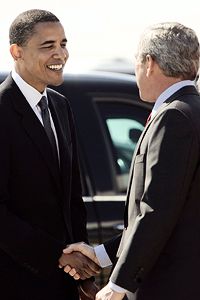
AP Photo/Gerald Herbert
They want to cooperate on reducing petroleum waste. Congress won't stand for that!
Creatine -- Safe? As recently as the Mark McGwire controversy, creatine was assumed to be steroidlike; i.e., to have a really dramatic effect on muscle building but awful side effects. Research suggests neither is true. Studies do not find creatine use to cause serious side effects, and as a result, creatine is not on the NCAA's list of banned substances. (The NCAA attitude toward creatine is that athletes are allowed to take it but that coaches and trainers are forbidden to instruct them to.) Just as studies don't find creatine dangerous, most athletes who have used the compound don't report instant magic muscle building, either.
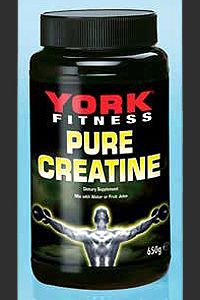
TBD
Once feared, now it appears reasonably safe.
Missing Universe Update: Fritz Zwicky of Caltech noted in 1933 that large clusters of galaxies don't contain enough visible matter to keep themselves from flying apart. By the 1980s, it had become apparent that individual galaxies don't contain enough visible matter to hold their stars. This triggered the searches for "dark energy" and "dark matter," postulated cosmic forces. Many projects are seeking evidence of dark energy and dark matter, including the Korean Invisible Mass Search, a set of detectors buried inside Jeombong Mountain. The latest estimate from NASA's Microwave Anisotropy Probe suggests that space is 4 percent ordinary matter, 22 percent dark matter and 74 percent dark energy. What might dark energy and dark matter be? No one has the slightest idea. We can't locate 96 percent of the universe. But trust us, we're experts!
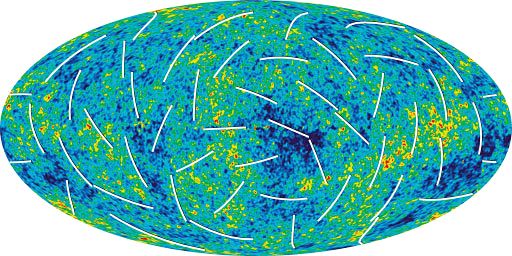
NASA/WMAP Science Team
It's a great outer-space map, except that 96 percent of the universe is missing.
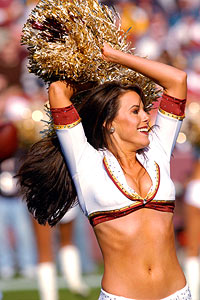
Greg Fiume/Getty Images
The football gods were torn: cheerleader professionalism versus the visiting team going for it in its own territory.
Those Hollywood Searchlights Around Gore's Home Sure Eat Power: Gore wasn't the first quack to win the Nobel Peace Prize, and history suggests he will not be the last. Gore spent eight years in the White House, and in that time took no meaningful action regarding greenhouse gases. The Clinton-Gore administration did not raise fuel economy standards for cars and trucks or propose domestic carbon trading. Though Clinton and Gore made a great show of praising the Kyoto Protocol, they refused even to submit the treaty to the Senate for consideration, let alone push for ratification. During his 2000 run for the presidency, Gore said little about climate change or binding global-warming reforms. In the White House and during his presidential campaign, Gore advocated no consequential action regarding greenhouse gases; then, there was a political cost attached. Once Gore was out of power and global-warming proposals no longer carried a political cost -- indeed, could be used for self-promotion -- suddenly Gore discovered his intense desire to demand that other leaders do what he had not! It is a triumph of postmodernism that Gore won the Nobel Peace Prize for no specific accomplishment other than making a movie of self-praise. Gore caused no peace nor led any reconciliation of belligerent parties nor performed any service to the dispossessed, the achievements the Peace Prize was created to honor. All Gore did was promote himself from Hollywood, and for this, he gets a Nobel. Very postmodern.
An annoying complication of Gore's Nobel is that few realize the award was given jointly to him and to the Intergovernmental Panel on Climate Change, an organization well worthy of distinction. The IPCC is a group of scientists who have spent two decades studying climate change in obscurity, and in many cases without pay. The IPCC's efforts have been selfless, motivated only by concern for society. Had the Nobel Peace Prize gone solely to the IPCC, it would have been a great day.An astonishing measure of how out-of-touch the Norwegian Nobel Committee seems is that it gave a prize to Gore for hectoring others about energy consumption in the same year it was revealed that Gore, at his home, uses 20 times the national power average. Gore's extraordinary power waste equates to about 377,000 pounds of greenhouse gases annually, or about 20 Hummer Years worth of global warming pollution. (A Hummer Year, TMQ's metric of environmental hypocrisy, is the amount of carbon dioxide emitted in a typical year of driving a Hummer.) When his utility bill made the news -- though apparently not in Oslo -- Gore responded by saying he buys carbon offsets. That takes you back to the offset problem: All offsets do is prevent greenhouse gas accumulation from increasing. If you really believe there will be a global calamity unless greenhouse gas emissions are reduced 80 percent, as Gore told the Live Earth crowd, you would buy offsets and cut your own energy use. Instead, Gore flies around in fossil-fuel-intensive jet aircraft telling others: Do as I say, not as I do!
After news of Gore's personal energy consumption broke, Gore spokeswoman Kalee Kreider told The Associated Press the utility bill was justified because "Al and Tipper both work out of their home." This raises the question -- what kind of work are they doing? Perhaps reanimating Frankenstein; in Frankenstein movies, there is always a lot of electricity crackling wastefully about. Here are other possible reasons the Gores' home requires so much energy:
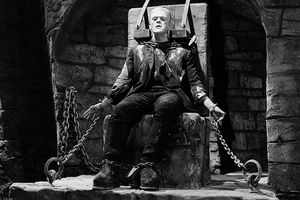
John Kobal Foundation/Getty Images
In the dungeon of Al Gore's home, electricity is being used wastefully.
• The former vice president is doing everything he personally can to cause global warming, so he can claim his predictions came true.
• Gore is growing marijuana in his basement. [Note from the corporate legal department: This is strictly a joke, ESPN is not accusing Al Gore of growing marijuana. We stand by our allegation that he is a sinister kingpin of international rare-bird smuggling.]
• Members of Gore's species require high power levels to maintain human form.
• Al and Tipper don't just leave the lights on when they make out, they leave the lights on all over the house.
Buck-Buck-Brawckkkkkkk: With the score Denver 20, Kansas City 8 in the third quarter, the Flintstones faced fourth-and-4 on the Broncos' 20. Herm "I Honor My Contract When I'm in the Mood" Edwards sent in the field goal unit. Oh great -- now it's a nine-point deficit! Kansas City did not score again. Note: With Denver leading 6-5, Kansas City faced third-and-2 on the Broncos' 5. Priest Holmes, getting his first start since 2005, took a toss, tried to reverse field and ended up losing 13 yards. Never run backward!
Corporate Involvement Update: Last fall's Briscoe High Nike commercial made corporate interest in high school football official. Besides Nike, McDonald's now sponsors a high school football challenge weekend in Ohio and Allstate Insurance markets at high school games. CBS has purchased CSTV, which in turn purchased the high school sports Web site MaxPreps.com. CSTV says it plans to begin offering video-on-demand of high school football games.
NFL Follows NFHS Lead: Two months ago, Tuesday Morning Quarterback reported that the National Federation of High Schools, rulemaking body for high school sports, changed its rules for 2007 to mandate ejection of players engaging in deliberate helmet-to-helmet contact. I wrote, "How about it NCAA and NFL, why not make your helmet-hits rules stricter too?" Last week, the NFL announced that players will be ejected for deliberate helmet-to-helmet contact.

AP Photo/Kevin P. Casey
Chestnuts roasting on an open latte ... it's mid-November at Starbucks!

Indiana University
On the hour, they ring pleasing airs of Christmas carols as the November leaves fall.
TMQ to ESPN: I'm Just Not Motivated to Write for $65 Million, It Must Be $85 Million. Since I slam Nancy Pelosi elsewhere, let's praise her for last week guiding through the House a "patch" of the Alternative Minimum Tax: The patch will reduce taxes on the upper middle class while increasing taxes on the wealthy, specifically, on managers of hedge funds and private equity funds. The Senate has yet to act on these issues, and it seems inclined to maintain the tax favors for hedge fund and private equity fund managers, who tend to be country-club buddies of senators. The issue is that managers of hedge funds and private equity funds generally receive their income as a percentage of profit on money they manage for investors. Although this sure sounds like a management fee, and thus income under tax laws -- meaning, taxed at a top rate of 35 percent -- managers of hedge funds and private equity funds claim their paychecks are actually capital gains, thus taxed at 15 percent.
Since a movement began in Congress to clarify tax laws and classify the money in question as income, managers of hedge funds and private equity funds have been donating to members of Congress at a headlong clip and arguing that their tax favors are needed to inspire risk taking and entrepreneurial behavior. Risk taking and entrepreneurial behavior by capitalists is in society's interest, as both lead to job creation. Society definitely does not want to discourage risk taking by capitalists. But here is where the argument becomes absurd. Suppose a hedge fund manager has a payday of $100 million. Under current tax law, his net would be $85 million; under the proposed changes passed by the House, his net would be $65 million. To accept the hedge fund managers' position, you have to believe that after the tax-law change they would say, "Sorry, $65 million is nowhere near enough to inspire me to come to the office and sit at a desk, I am giving up on working." The CEO of Blackstone was paid $400 million in 2006; if his net on such a sum declined from $340 million to $260 million, would he really refuse to report to his office? Drop the manager's pay to $1 million and the same obtains -- today his net is $850,000; tomorrow his net declines to $650,000. How many people are going to say, "I refuse to review investment proposals for only $650,000 a year; I just don't feel like being entrepreneurial anymore."
It is selfish for executives of hedge funds and private equity funds, who are already among society's most favored and luckiest individuals, to demand they receive even more luxury when millions cry themselves to sleep because of money worries. And if the Senate refuses to close the hedge fund loophole, this will be another example of what TMQ calls the "sliver strategy" -- senators will cost society billions of dollars to channel a mere sliver, a few million, into their campaign war chests. It would be much cheaper to average taxpayers to have public financing of congressional campaigns, coupled with ending campaign contributions and closing all the tax loopholes that favor the very rich.
This Fulfills My Obligation to Say Something About Chicago at Oakland: The Raiders are 2-6, their season shot, and they just scored six points at home. Explain to me again what is being accomplished by not playing first-overall draft choice JaMarcus Russell?
More Proof of the Decline of Western Civilization: Borders announced it will install wide-screen televisions on the walls of its bookstores.
Why Certain Teams Are 0-9: Leading 3-0, Miami prepared to go for it on fourth-and-1 from the Buffalo 48, but the Dolphins were called for a play-clock violation and punted after the penalty. Why do I mention this? There was a timeout after the previous down, yet Miami ended up taking too much time. Still ahead 3-0, Miami faced third-and-7 from its 5. As Cleo Lemon retreated into his end zone, five Marine Mammals offensive linemen blocked three Buffalo rushers, leaving running back Jesse Chatman one-on-one against defensive end Chris Kelsey, who recorded the safety. The quarterback is retreating into his end zone and only a 5-8, 223-pound tailback is assigned to block a defensive end! Meanwhile, I don't wish to alarm you, but Buffalo has won five of its past six.
Prep School Confidential No. 1: As recently as a decade ago, most expensive, snobby private high schools were content to feature preppy sports such as tennis and lacrosse. But with the explosion of popularity of football, many rich-kid schools now want winning football programs. Public high schools in many parts of the country have begun to complain that the private prep schools are cherry-picking the best football players by offering full-ride scholarships, often to boys from working-class or impoverished backgrounds. Doesn't it sound like a good idea to have boys from working-class or impoverished backgrounds attending snobby prep schools? Here's the rub. Nearly all states require high school students to pass a proficiency exam to graduate. Private high schools are bound by no such rules: They grant diplomas to whom they please, based on whatever criteria they please, and have no legal obligation to educate.
If a private high school wants to recruit football players, not require them to go to class, then issue them diplomas, this is perfectly legal -- though the same practice would cause a huge scandal at a public high school. My big worry about the fad for expensive private high schools fielding good football teams is that they are essentially hiring players, making little attempt to educate them, then handing out diplomas and praising themselves for their wonderful graduation stats. The great private prep schools with high standards, such as DeMatha in Hyattsville, Md., turn out well-educated athletes. But as we've learned, not everyone in sports has high standards. If you know of a private high school that is recruiting football or boys' basketball players but not educating them, report the specifics using the address at Reader Animadversion.
Prep School Confidential No. 2: The NCAA finally has begun cracking down on "diploma mills," places that are high schools only on paper and will award a functionally illiterate person a high school degree to enable participation in college sports. Amusingly, it is the advent of the Internet, and satellite-mapping features such as Google Earth, that have made the crackdown feasible. Now, it's easy to determine whether an address that claims to be a high school is a school or a storefront.
Assuming diploma mills are eliminated, that leaves the question of perfectly legitimate sports prep schools, such as Milford Academy in New Berlin, N.Y. For decades, male athletes (now female, as well) who got poor grades in high school have done an extra year at places such as Milford, completing their course requirements so they qualify for NCAA sports. Places like Milford are godsends to kids who goofed off in high school and need to get serious about life. College coaches often encourage parents to send their boys (and now their girls) to sports prep schools because that means the athlete will arrive at college one year older and more physically mature, without any sacrifice of NCAA eligibility. For parents, the decision is an economic wager. Private sports prep schools charge $25,000 to $30,000 for what is in effect an extra year of high school, but they boast that a high percentage of graduates land NCAA scholarships. If parents pay $30,000 for a prep year then pay nothing for college, they've come out ahead.
The concern about sports-prep academies is that many kids arrive having passed only a handful of high school credits, then get their credits rubber-stamped by the prep school. TMQ continues to think the NCAA does nowhere near enough to enforce academic standards, in effect misusing for profit thousands of college athletes who will never earn a dime as professional athletes and don't realize until it is too late, when their eligibility is exhausted, that they have blown their chance for a college education. Recently, however, the NCAA made two quiet rule changes that do shift some focus toward academics. First, the NCAA ruled that Division I athletes must have completed 16 high school credits, up from the previous requirement of 14. Sixteen credits is hardly ambitious -- that's four academic courses per year -- but it does raise the bar from 14, which was plain easy.
More important, henceforth the NCAA will allow only one credit to be completed after graduation from high school. Previously, an athlete could leave high school with ridiculously low achievement -- only a few credits passed -- then have his parents take loans to pay for a prep school and suddenly, on paper, become a fabulous student as the prep school certified completion of multiple credits. Economically, parents were paying a $30,000 fee to avoid the potentially much higher cost of college. Starting soon, Division I athletes will need to complete 15 of their 16 credits while in high school or no NCAA athletic scholarship. As word of the new rule spreads, many football and boys' basketball stars who were expecting to take their high school years off will face the shocked realization that they actually must pass 15 high school credits. It's a really good rule -- hats off to the NCAA on this one.
The Football Gods Were Not Torn: Kickoff temperature 61 degrees with rain, the high-aesthetic-appeal Chargers Girls wore racy two-piece hot-weather outfits. Surely the football gods were appeased. Peyton Manning threw six interceptions. This one was an easy choice for the football gods, and this item creates a perfectly legitimate reason to link to photos of the Chargers' cheerleaders in their racy attire. Worry for San Diego faithful: The Bolts' offense was invisible for the second straight week.
Down 21-9 at the Half Is Not a Panic Situation for a Good Team: Sportscasters touted the Pittsburgh defeat of Cleveland as a "dramatic comeback," but a 21-9 halftime deficit at home, for a quality team, is simply an obstacle to be overcome. After the intermission, Pittsburgh had just as much time to come back as Cleveland had consumed to take its lead. The Steelers ended up outgaining the Browns 401 yards to 163 yards on offense; Cleveland kickoff returns kept the score close. At the endgame, Romeo Crennel made a vexing coaching error. Pittsburgh scored to take a 31-28 lead with 3:21 remaining. Crennel challenged the touchdown, though the catch was obviously good. Losing a timeout on the challenge, Crennel then called timeout, for a total of two expended. Three minutes later, the Browns were at the Pittsburgh 35 and had to spike the ball to stop the clock, attempting a long field goal that wheezed just short. Had Crennel not wasted two timeouts, the Browns would have had a good chance at the field position needed for a tying kick.
Ravens: Train-Wreck Team: A week ago, TMQ wrote of the Ravens, "Last year's successful if predictable formula for Baltimore was power defense and clock-control rushing; this year's unsuccessful formula is pass-wacky futility," citing far too many passes and not enough rushes in the first half of a blowout defeat. On Sunday, Baltimore coaches called 21 passes in the first half versus 12 rushes -- and failed to score. With Cincinnati leading 6-0, Baltimore reached second-and-goal from the Bengals' 1 with 21 seconds in the first half, holding one timeout and the home crowd roaring at military-afterburner decibels. Power rush? Incompletion on second-and-goal, interception on third-and-goal. Ye gods! Since taking the field in January with a 13-3 record and after a restful bye week, Baltimore is 4-6.
Obscure College Score of the Week: Richmond 62, Delaware 56 in five overtimes. Forty-two points were scored in overtime as the Spiders defeated the Blue Hens in a contest pitting two of sports' oddest nicknames. Delaware ran 98 offensive plays, yet lost. Located in Richmond, Va., the University of Richmond sponsors the Richmond Quest, a program that biennially awards a $25,000 check to the student who submits the most important question Richmond courses should address. Here is the current winner. Be sure to scroll down to the list of speakers Richmond hopes to invite to discuss the $25,000 question.

20th Century Fox
It's been a while since we had a legitimate-sounding reason to include a photo of special appeal to female readers.
Wednesday: No readers' column tomorrow; it will return next week.
Next Week: Inspectors discover Al Gore is using huge amounts of electricity to download all the world's bootleg copies of the movie "Dude, Where's My Car?"
In addition to writing Tuesday Morning Quarterback, Gregg Easterbrook is the author of "The Progress Paradox: How Life Gets Better While People Feel Worse" and other books. He is also a contributing editor for The New Republic, The Atlantic Monthly and The Washington Monthly.

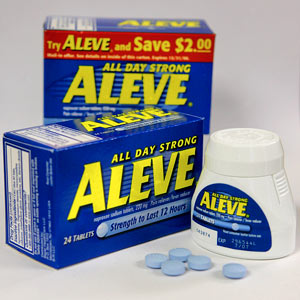


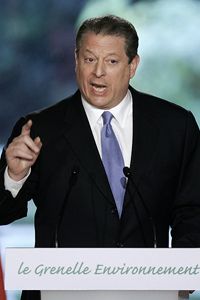
Comments
You must be signed in to post a comment